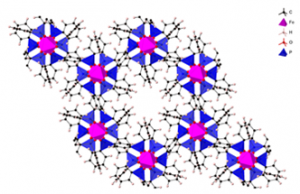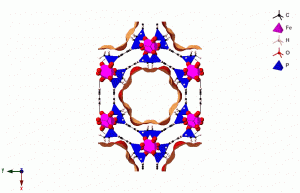Contact person: Jan Demel
Metal-organic frameworks (MOFs) are a novel class of crystalline materials composed of metal centres (secondary building units, SBU) connected by organic linkers via coordination bonds. The tunability of the pore size, crystal topology, and chemical nature of the structures make MOFs hot candidates for applications like gas storage and separation, heterogeneous catalysis, sensors, adsorbents, drug delivery systems, and many others.
One of the drawbacks of many MOFs is their low stability in water that comes from the lability of the coordination bonds towards hydrolysis. For this reason, we focus on the preparation of novel MOFs with high hydrothermal stability.
In our group, we have developed linkers bearing phosphinic acid groups and combined them with hard metals (according to Pearson’s HSAB theory, e.g., Fe3+) to construct MOFs with high hydrothermal stability. The first examples are MOFs ICR-2 and ICR-4 (ICR stands for Inorganic Chemistry Řež).
Additionally, we investigate the mechanisms of MOF degradation, mainly the degradation of zirconium MOFs (e.g., UiO-66, PCN-222). We combine classical methods (powder XRD and adsorption of N2) with highly sensitive analytical methods for detection of free linkers and metals in solutions of given pHs (HPLC and ICP). We utilize them, e.g., for organophosphate degradations including warfare chemical agents.
We also synthetize MOFs made of photosensitizers in the form of nanoparticles for photodynamic therapy of cancer (PDT). In this strategy, these nanometer sized MOFs (nanoMOFs) are internalised by cancerous cells. Then, internalized photosensitizers upon visible light irradiation produce reactive oxygen species (mainly singlet oxygen) within the cell that leads to cell death.
References:
[1] J. Hynek, P. Brázda, J. Rohlíček, M. G. S. Londesborough, J. Demel: Phosphinic Acid Based Linkers: Building Blocks in Metal–Organic Framework Chemistry, Angew. Chem. Int. Ed. 2018, 130, 5110-5113
[2] J. Hynek, S. Ondrušová, D. Bůžek, P. Kovář, J. Rathouský, J. Demel: Postsynthetic modification of a zirconium metal-organic framework at the inorganic secondary building unit with diphenylphosphinic acid for increased photosensitizing properties and stability, Chem. Commun. 2017, 53, 8557-8560
[3] D. Bůžek, J. Demel, K. Lang: Zirconium Metal-Organic Framework UiO-66: Stability in Aqueous Environment and its Relevance for Organophosphate Degradations, Inorg. Chem. 2018, 57, 14290-14297
[4] D. Bůžek, J. Zelenka, P. Ulbrich, T. Ruml, I. Křížová, J. Lang, P. Kubát, J. Demel, K. Kirakci, K. Lang: Nanoscaled porphyrinic metal-organic frameworks: photosensitizer delivery systems for photodynamic therapy, J. Mater. Chem. B 2017, 5, 1815-1821
[5] J. Hynek, S. Jurík, M. Koncošová, J. Zelenka, I. Křížová, T. Ruml, K. Kirakci, I. Jakubec, F. Kovanda, K. Lang, J. Demel: Nanoscaled metal-organic framework ICR-2 as a carrier of porphyrins for Photodynamic Therapy, Beilstein J. Nanotechnol. 2018, 9, 2960-2967


